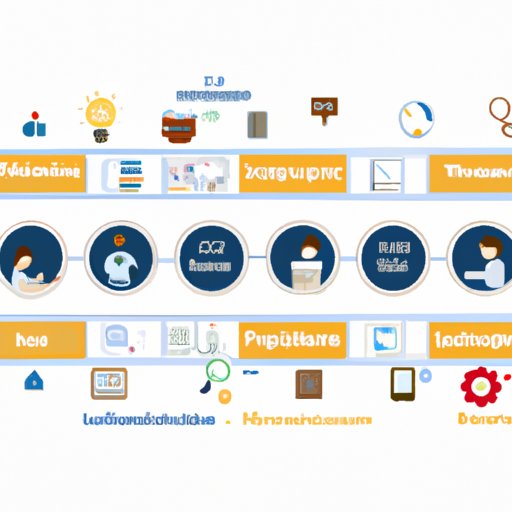Introduction
Technology integration is the process of incorporating technology into everyday life. It involves using technological tools to improve efficiency, communication, and collaboration. This type of integration has become increasingly important in the modern world as technology continues to evolve and become more pervasive in our daily lives. In this article, we will explore what is technology integration, its benefits, and how it can be successfully implemented in educational settings.
Exploring Technology Integration in Education: What it is and How it Works
Technology integration in education is the use of technology to enhance teaching and learning. This includes the use of computers, tablets, smartphones, software, online resources, and other technological tools to support instruction, assessment, and communication. Technology integration in education can take many forms, from providing students with access to online resources to using interactive whiteboards and multimedia presentations in the classroom.
The types of technology used in educational settings vary depending on the needs of the school or district. Some commonly used technologies include computers, tablets, laptops, mobile devices, projectors, interactive whiteboards, software applications, and online resources. Each of these technologies can be used to facilitate learning, increase engagement, and support instruction.
The benefits of technology integration in education are numerous. Technology can help teachers to provide more engaging and effective instruction, while also allowing students to access additional resources and information. Technology can also help to make the learning process more efficient, by providing students with access to a wide range of materials and resources that can be accessed quickly and easily. Additionally, technology can help to reduce the amount of time needed for teaching, assessment, and communication, freeing up more time for hands-on activities and individualized instruction.

Understanding Technology Integration in Schools
When integrating technology into the classroom, there are several factors to consider. One of the most important is the availability of resources. Many schools and districts lack the necessary funding to purchase the latest technologies or to hire staff to manage them. Additionally, not all teachers are comfortable with or knowledgeable about technology, which can limit its effectiveness.
Another challenge faced when integrating technology into the classroom is finding the right tools for each subject. For example, a math lesson may require a different type of technology than a history lesson. It is important to select tools that are appropriate for each subject and age group, as well as those that are cost-effective and easy to use.

A Guide to Implementing Technology Integration in the Classroom
In order to effectively integrate technology into the classroom, educators must first develop a comprehensive technology plan. This should include an assessment of the available resources and an analysis of the current technology needs. The plan should also identify the goals for technology integration and outline the steps for implementing it. Once the plan is in place, educators can begin to assess the available resources and identify appropriate technologies for each subject.
Once the appropriate technologies have been identified, educators can begin to implement them in the classroom. This includes developing digital literacy skills and creating an engaging learning environment. Educators should also ensure that the technology is integrated into the curriculum, so that students can learn how to use the technology in meaningful ways. Finally, educators should ensure that the technology is regularly assessed and updated to keep pace with changing educational needs.
Strategies for Successful Technology Integration in Teaching and Learning
In order to ensure successful technology integration in teaching and learning, educators must develop digital literacy skills. This includes understanding how to use the technology, navigating different software applications, and troubleshooting any technical issues that arise. Additionally, educators should create an engaging learning environment by incorporating interactive activities and multimedia elements into their lessons.
Educators should also integrate technology into the curriculum. This can involve using technology to supplement traditional materials, such as textbooks, and providing students with access to online resources. Furthermore, educators should ensure that technology is used to promote active learning. This includes encouraging collaboration and providing opportunities for students to take ownership of their learning.

Examining the Role of Technology Integration in Student Achievement
Technology integration can play an important role in student achievement. By providing students with access to digital resources and teaching them how to use technology in meaningful ways, educators can help to improve student performance. Additionally, technology can be used to measure student performance, allowing educators to assess the impact of technology on student learning. Technology can also be used to provide feedback to both students and teachers, helping to further improve student achievement.
Conclusion
Technology integration is an important part of modern education, and its benefits are numerous. Technology can help to improve teaching and learning, increase engagement, and reduce the amount of time needed for instruction. Additionally, technology can play an important role in student achievement by providing access to digital resources, measuring performance, and providing feedback. To ensure successful technology integration, educators must develop a comprehensive technology plan, assess available resources, and integrate technology into the curriculum. With the right strategies in place, technology integration can be a powerful tool for improving student outcomes.
(Note: Is this article not meeting your expectations? Do you have knowledge or insights to share? Unlock new opportunities and expand your reach by joining our authors team. Click Registration to join us and share your expertise with our readers.)
